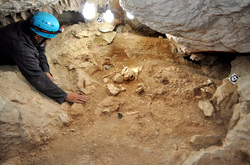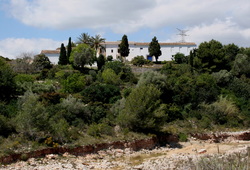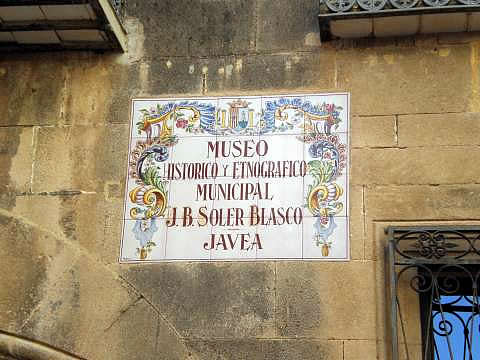 Amjasa and the Town hall collaborate in this great archaeological project initiated by the Cirne Cultural Foundation The new phase completed the sifting of the strata of sediment which contained ten human burials from the neolithic period. which carbon14 dating put between 2670 and 2250 BC. The remains were accompanied by grave goods, including tools such as arrowheads, stone axes, ceramic vessels, jewelry made with sea-shells and bones fashioned into needles. The archaeologist who led the excavation, Juan de Dios Boronat, highlighted the finding of a punch.made of copper This material was very unusual for the period and was undoubtedly imported from somewhere distant from Xàbia. It contextualises the changing times. Another important result was obtained in a survey of another, deeper layer of the cave, about 20 cm below the burials previously studied. Boronat revealed this was the discovery of more, earlier, skeletal remains, which reveal the presence of other burials made between 200 and 300 years before those previously analysed. All the results of the excavations are being recorded with the innovative technique of photogrammetry, which has enabled the making of a documentary in 3D giving an idea of this inaccessible cavity in the Montgó.. This will be presented at a competition for scientific documentaries in Baracaldo. The importance of the archaeological site in the Migdia, which combine burials with rock paintings more than 5000 years old, began to be diivulged a few months ago through a comprehensive exhibition. This was was first displayed in the head office of the Cirne Cultural Foundation (which initiated and has coordinated this ambitious archaeological study), the Soler Blasco Museum in Xàbia and the MARQ in Alicante. It will now go to Guardamar del Segura and possibly then travel to Barcelona. Xàbia Town Hall and Amjasa, the Municipal water company, are contributing financially to the project. As explained by Mayor, José Chulvi: ...for Xàbia " ...it is a luxury and great fortune to have a foundation like Cirne" and argued that public institutions "could not but collaborate with what is very important work, with great scientific and social impact ". Therefore within the context of their responsibility to social and cultural activities, Amjasa signed a collaborative agreement which provides 16,000 euros to the Foundation, which in return will prepare an exhibition on local history related to water to be shown to schools next year. The Town Hall also included a first agreement to aid Cirne in the current budget. Its chairman, Enric Martinez gave thanks for the municipal involvement and announced projects upon which they are working such as the water exhibition and another which will provide a perspective on Xàbia in the 1940's and 1950's. Further collaboration with the cultural foundation is being channelled through the Museum and its archaeologist, Ximo Bolufer, who is involved in the Migdia excavations and the study of materials found. In addition, AMUX, the Friends of the Museum Association has offered assistance to the project through translation of the documentary about the cave into English. Translated from Press Release
1 Comment
 Sunday, 26 May 2013 Guided walk to Benitzaina led by local Xàbia archaeologists Joaquim Bolufer and Josep Castelló Departure: 09:30 from Las Ramblars landfill station AMUX offers a guided walk to the18th century fortified house of Benitzaina, situated in the area near the river Gorgos and at the municipal limits of Xàbia, Dénia and Gata, to which the house has given its name. Here you can still enjoy beautiful views over an agricultural landscape with vineyards and “Riuraus” - buildings especially erected for raisin production. The walk starts on a dirt road along the banks of the river, which it crosses a little later, and gently climbs the Camí de Benitzaina to the house and chapel of the same name. Here we will stop for refreshments. After the break, we will continue with a short ascent, turning off to look at a ‘Corral’ or animal pens. From there the path leads downstream and downhill to a ‘casa del campo’ or country house with an unusual raisin drying place made of stone walls. We continue along the banks of the river back to the point of departure. Departure is from the Ramblars landfill station at 09:30 Approaching from Xàbia on the Gata road, turn left into a small lane signposted ‘Ramblars’, about 300 metres past the petrol station Petronor. Continue a short distance along the lane until the control house, where you can leave your car. Difficulty: medium The route includes a short but gentle climb and an even more gentle descent. The road is stony in places Distance: 4.5 km. Duration: 3 hours We leave at 9.30 am and the excursion is calculated to last no more than three hours. Please bring lunch and water and wear suitable clothing and footwear. Don’t forget your hat! More information on Benitzaina, click on this link: http://es.wikipedia.org/wiki/Casa_fortificada_de_Benitzaina Friday 28 June: Next AMUX event for your diary: “Sopar de Cabasset” in the Riurau d'Arnauda in the Parque Montaner in Xàbia Pueblo. More details to follow. |
ACTIVITIES
Categories |
- Home
- Blogs
-
Projectes
- Premio de Investigación - Formularios de Inscripción
-
Traducciones Translations
>
-
DISPLAY PANELS - GROUND FLOOR
>
- THE STONE AGES - PALAEOLITHIC, EPIPALAEOLITHIC AND NEOLITHIC
- CAVE PAINTINGS (ARTE RUPESTRE)
- CHALCOLITHIC (Copper) & BRONZE AGES
- THE IBERIAN CULTURE (THE IRON AGE)
- THE IBERIAN TREASURE OF XÀBIA
- THE ROMAN SETTLEMENTS OF XÀBIA
- THE ROMAN SITE AT PUNTA DE L'ARENAL
- THE MUNTANYAR NECROPOLIS
- ARCHITECTURAL DECORATIONS OF THE PUNTA DE L'ARENAL
- THE ATZÚBIA SITE
- THE MINYANA SMITHY
- Translations archive
- Quaderns: Versión castellana >
- Quaderns: English versions >
-
DISPLAY PANELS - GROUND FLOOR
>
- Catálogo de castillos regionales >
- Exposició - Castells Andalusins >
- Exposición - Castillos Andalusíes >
- Exhibition - Islamic castles >
- Sylvia A. Schofield - Libros donados
- Mejorar la entrada/improve the entrance >
-
Historia y enlaces
-
Historía de Xàbia
>
- Els papers de l'arxiu, Xàbia / los papeles del archivo
- La Cova del Barranc del Migdia
- El Vell Cementeri de Xàbia
- El Torpedinament del Vapor Germanine
- El Saladar i les Salines
- La Telegrafía y la Casa de Cable
- Pescadores de Xàbia
- La Caseta de Biot
- Castell de la Granadella
- La Guerra Civil / the Spanish civil war >
- History of Xàbia (English articles) >
- Charlas y excursiones / talks and excursions >
- Investigacions del museu - Museum investigations
- Enllaços
- Enlaces
- Links
-
Historía de Xàbia
>
- Social media
- Visitas virtuales
- Tenda Tienda Shop


 RSS Feed
RSS Feed
